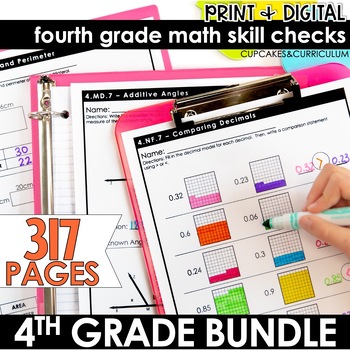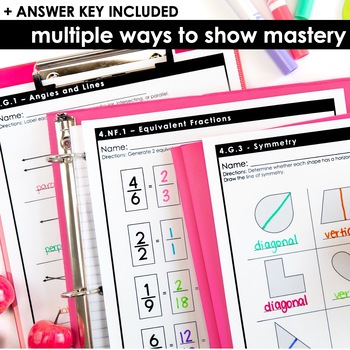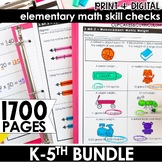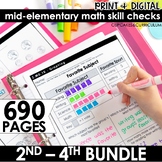4th Grade Math Worksheets for Place Value, Arrays, Fractions and Geometry
- Zip
What educators are saying
Products in this Bundle (28)
showing 1-5 of 28 products
Bonus
Also included in
- This BUNDLED math 3rd-5th grade resource includes printable and digital math worksheets that give your third, fourth and fifth graders practice with ALL intermediate math skills like addition and subtraction, multiplication, division, algebraic concepts, geometry, measurement, data and more. TeacherPrice $108.00Original Price $215.75Save $107.75
- This BUNDLED K-5 math resource includes printable and digital math worksheets that give your elementary learners practice with ALL math skills like counting, addition and subtraction, multiplication, division, algebraic concepts, geometry, measurement, data and more. Teachers, interventionists, coacPrice $203.00Original Price $404.60Save $201.60
- This BUNDLED math resource includes printable and digital math worksheets that give your second, third, and fourth graders practice with ALL mid-elementary math skills like addition and subtraction, multiplication, division, algebraic concepts, geometry, measurement and data and more. These Common CPrice $105.00Original Price $200.50Save $95.50
Description
This BUNDLED fourth grade grade math resource includes printable and digital math worksheets that give your fourth graders practice with ALL fourth grade grade math skills like addition and subtraction, multiplication, division, algebraic concepts, decimals, fractions, angles, measurement and data and more. These Common Core aligned math quick checks are perfect for morning work, assessment, homework, review, fast-finisher activities, exit tickets, and math centers.
These math worksheets are provided in THREE formats to best fit your classroom needs – Print and Go, Google Slides, and JPEG.
Included in this BUNDLED resource
4.NBT.1 - Place Value
- Fill in the blank to show value of underlined digit (2 pages)
- Fill in the blank to show place value of underlined digit (2 pages)
- Compare value based on place (2 pages)
- Write number when given rule (2 pages)
- Fill in the blanks to make number sentences true (2 pages)
4.NBT.2 - Number Form and Comparing Numbers
- Answer questions about a given number (2 pages)
- Identify numbers in a set with largest or smallest value (2 pages)
- Make the greatest and smallest numbers possible when given a set of digits (2 pages)
- Answer true or false to a number comparison and explain thinking (1 page)
- Write > < or = to make a given statement true (1 page)
- Write a number that fits the description (1 page)
- Write numbers in expanded form (1 page)
4.NBT.3 - Rounding
- Complete number lines and round to given place value (2 pages)
- Round numbers to a given place value (2 pages)
- Round a number to nearest 10 and 100 (2 pages)
- Use open number lines to round to nearest 100 (1 page)
- Use open number lines to round to nearest 1000 (1 page)
- Name numbers that fit a description and explain thinking (2 pages)
4.NBT.4 - Add and Subtract
- Subtract with no borrowing (3 pages)
- Subtract with borrowing (5 pages)
- Subtract across zeroes (2 pages)
- Add with no carrying (2)
- Add (8 pages)
- Find the missing addend (4 pages)
4.NBT.5 - Multiplication
- Multiply 2- 3- or 4-digit numbers by 1 digit numbers (5 pages)
- Multiply 2-digit by 2-digit numbers (5 pages)
- Multiplication word problems (5 pages)
4.NBT.6 - Division
- Divide 2- 3- or 4- digits by 1-digit no remainders (2 pages)
- Divide 2- 3- or 4- digits by 1-digit remainders (2 pages)
- Divide 2- 3- or 4- digits by 1-digit mixed (6 pages)
- Division word problems (5 pages)
4.OA.1 - Interpreting Multiplication Equations
- Write a multiplication equation when given a comparison statement (3 pages)
- Write a comparison statement when given a multiplication equation (3 pages)
- Solve multiplicative comparison word problems (4 pages)
4.OA.2 - Multiplicative Comparison Word Problems
- Solve multiplicative comparison word problems (8 pages)
- Write a multiplicative comparison word problem when given an equation (2 pages)
4.OA.3 - Multi-Step Word Problems
- Solve multi-step word problems (10 pages)
4.OA.4 - Factors/Prime & Composite Numbers
- Find factors for given numbers (2 pages)
- Answer YES/NO questions about factors; explain reasoning (1 page)
- Use arrays to prove/disprove a statement about factor pairs (1 page)
- List multiples of given numbers (2 pages)
- Color prime numbers and explain what a prime number is (1 page)
- Color composite numbers and explain what a composite number is (1 page)
- Circle prime or composite numbers in a given set of numbers (2 pages)
4.OA.5 - Rules and Patterns
- Use tables to solve word problems (1 page)
- Use given rule to continue the pattern (2 pages)
- Observe the pattern to identify the rule (1 page)
- Identify the rule, then complete the pattern (1 page)
- Match a given pattern to its rule (2 pages)
- Extend a repeating visual pattern (1 page)
- Predict what a future visual pattern will look like (2 pages)
4.NF.1 - Equivalent Fractions
- Decompose shapes to create equivalent fractions (2 pages)
- Circle equivalent fraction from a set (1 page)
- Shade in and name equivalent fractions using fraction bars (2 pages)
- True/False (2 pages)
- Generate equivalent fractions (2 pages)
- Circle equivalent fractions from a set (1 page)
4.NF.2 - Comparing Fractions
- Write <, >, or = when given 2 fractions with uncommon denominators (2 pages)
- Order a set of fractions with uncommon denominators from greatest to least (1 page)
- Order a set of fractions with uncommon denominators from least to greatest (1 page)
- Name fractions and then compare using <, >, or = (2 pages)
- Determine true and false inequalities (2 pages)
- Name a fraction in between 2 given fractions (2 pages)
4.NF.4 - Multiplying Fractions
- Decompose fractions to make multiplication expressions (2 pages)
- Use a number line to solve a whole number multiplied by a unit fraction (2 pages)
- Multiply the fractions using a model (2 pages)
- Multiply the fractions using a number line (2 pages)
- Word problems (2 pages)
4.NF.5 - Equivalent Fractions | Tenths and Hundredths
- Write an equivalent fraction when given a fraction with 10 or 100 in the denominator (2 pages)
- Name a fraction based on a model, then name the equivalent fraction (1 page)
- Add fractions with 10 and 100 in the denominator (3 pages; varying difficulty)
- Shade in a model to make an equivalent fraction, then name the fractions (2 pages)
- Name fractions, then add when given a model (2 pages)
4.NF.6 - Fractions as Decimals
- Convert fractions to decimals (4 pages)
- Convert decimals to fractions (2 pages)
- Fill in fraction, word form, or decimal form (2 pages)
- Write fraction and decimal based on model (2 pages)
- Write a decimal and place on number line when given fraction (2 pages)
4.NF.7 - Comparing Decimals
- Compare decimals using >, <, or = (2 pages)
- Place decimals on number line, then compare (2 pages)
- Draw decimals on model, then compare (2 pages)
- Circle which the decimal is closest to: 0, 1/2, or 1 (2 pages)
- Order 3 decimals from least to greatest (1 page)
- Order 3 decimals from greatest to least (1 page)
4.G.1 - Angles and Lines
- Label angles as right, obtuse, or acute (2 pages)
- Label lines as perpendicular, parallel, or intersecting (1 page)
- Label lines and angles using word bank (1 page)
- Answer questions about angles in shapes (1 page)
- Indicate whether a shape has perpendicular lines, parallel lines, both or neither (1 page)
- Draw shapes, lines, or angles with given properties (2 pages)
- Answer questions about lines and angles based on a map (2 pages)
4.G.2 - Classify Shapes
- Label triangles as right, acute or obtuse (1 page)
- Use a set of polygons to answer questions (2 pages)
- Draw shapes with given properties (1 page)
- Indicate angles, sides, and more by completing a table (3 pages)
- Match the shape to its description (1 page)
- List 3 properties of a given shape (1 page)
- Cut and paste quadrilaterals into the correct category. (1 page)
4.G.3 - Lines of Symmetry
- Recognize and label lines of symmetry in the alphabet (2 pages)
- Recognize lines of symmetry as vertical, horizontal, or diagonal (1 page)
- Pick shape that isn't symmetrical out of a set; draw lines of symmetry on other shapes in set (1 page)
- Pick objects that shows correct drawing of lines of symmetry in a set (2 pages)
- Draw lines of symmetry in objects (2 pages)
- Complete the drawing (2 pages)
4.MD.1 - Measurement (Metric and Customary)
- Convert customary measurements (4 pages)
- Convert metric measurements (2 pages)
- Convert measurements from a table (8 pages)
- 2 conversion charts included (1 metric, 1 customary)
4.MD.2 - Measurement Word Problems/Story Problems
- Solve word problems involving units of measurement (10 pages)
4.MD.3 - Area and Perimeter
- Find the area and perimeter of quadrilaterals (4 pages)
- Find the value of one side and the perimeter when given the area of a shape (4 pages)
- Area and perimeter word problems (2 pages)
4.MD.4 - Line Plot/Fraction Addition and Subtraction
- Plot given data on a line plot and solve addition and subtraction equations based on the data (10 pages)
4.MD.5 - Angles and Fractional Parts of Circles
- Determine if an angle is right, obtuse or acute when given a measurement (3 pages)
- Calculate the angle measurement of an angle in a circle when given the fractional part (3 pages)
- Choose the most logical measurement when given a picture of an angle (4 pages)
4.MD.6 - Measure and Draw Angles
- Use a protractor to measure the angles (6 pages)
- Label a measurement as acute, obtuse, or right and draw a sketch of the angle (4 pages)
4.MD.7 - Additive Angles
- Find the missing angle measurement when given a line/one angle (3 pages)
- Find the missing angle measurement in a triangle (2 pages)
- Find the measurement of a missing angle, then draw an angle given a description (5 pages)
All of these fourth grade math practice pages are included in three formats:
- Print and go: Printable pages for your students. Answer key included.
- Google Slides: Link to Google Slides presentation. All text boxes have been added for you, and some directions have been modified to fit the digital formatting. Students will need to be familiar with text, line, and scribble tools to complete this format.
- JPEG: individual JPEG files of each worksheet. This format is ideal for digital learning platforms like Seesaw where students can “draw” on top of a file using their finger or a stylus pen.
What makes these math quick checks better?
- Check for student understanding of a single skill in multiple ways
- Student centered design with easy-to-read fonts and minimal clipart
- Aligned with Common Core, but skill based to give you the ability to apply to any set of standards
- Print and digital formats to seamlessly adapt to your current learning environment
▁▁▁▁▁▁▁▁▁▁▁▁▁▁▁▁▁▁▁▁▁▁▁▁▁▁▁▁▁▁▁▁▁▁▁▁▁▁▁
What other grade levels do you need?
- Kindergarten Math Skill Checks
- First Grade Math Skill Checks
- Second Grade Math Skill Checks
- Third Grade Math Skill Checks
- Fourth Grade Math Skill Checks
- Fifth Grade Math Skill Checks
▁▁▁▁▁▁▁▁▁▁▁▁▁▁▁▁▁▁▁▁▁▁▁▁▁▁▁▁▁▁▁▁▁▁▁▁▁▁▁
Cupcakes & Curriculum ⇢ www.cupcakesncurriculum.com
Facebook | Pinterest | Instagram | Freebies | Teacher Tees
▁▁▁▁▁▁▁▁▁▁▁▁▁▁▁▁▁▁▁▁▁▁▁▁▁▁▁▁▁▁▁▁▁▁▁▁▁▁
Looking for some humor & positivity in your #teacherlife?
Join the conversation in our Facebook Group!
A LITTLE ABOUT THE AUTHOR
Hey there! I'm Jennifer, an experienced first, third, and fourth grade general education classroom teacher, I also have experience as a special education teacher's assistant and interventionist. I earned my Bachelors' degree in Family & Child Studies, and my Masters' degree in Elementary Education.
I've been creating resources on Teachers Pay Teachers since 2012 to help teachers like you find your work-life balance - you are so much more than just an awesome teacher!
If you have any questions about this resource, or if you'd simply like to 'talk teacher' with me, send me an email at jennifer@cupcakesncurriculum.com! ♥
▁▁▁▁▁▁▁▁▁▁▁▁▁▁▁▁▁▁▁▁▁▁▁▁▁▁▁▁▁▁▁▁▁▁▁▁▁▁








